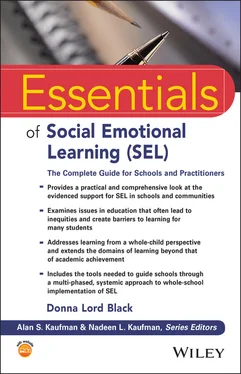Donna Lord Black - Essentials of Social Emotional Learning (SEL)
Здесь есть возможность читать онлайн «Donna Lord Black - Essentials of Social Emotional Learning (SEL)» — ознакомительный отрывок электронной книги совершенно бесплатно, а после прочтения отрывка купить полную версию. В некоторых случаях можно слушать аудио, скачать через торрент в формате fb2 и присутствует краткое содержание. Жанр: unrecognised, на английском языке. Описание произведения, (предисловие) а так же отзывы посетителей доступны на портале библиотеки ЛибКат.
- Название:Essentials of Social Emotional Learning (SEL)
- Автор:
- Жанр:
- Год:неизвестен
- ISBN:нет данных
- Рейтинг книги:5 / 5. Голосов: 1
-
Избранное:Добавить в избранное
- Отзывы:
-
Ваша оценка:
- 100
- 1
- 2
- 3
- 4
- 5
Essentials of Social Emotional Learning (SEL): краткое содержание, описание и аннотация
Предлагаем к чтению аннотацию, описание, краткое содержание или предисловие (зависит от того, что написал сам автор книги «Essentials of Social Emotional Learning (SEL)»). Если вы не нашли необходимую информацию о книге — напишите в комментариях, мы постараемся отыскать её.
Essentials of Social Emotional Learning (SEL): The Complete Guide for Schools and Practitioners
Essentials of Social Emotional Learning (SEL)
Essentials of Emotional Learning (SEL
Essentials of Social Emotional Learning (SEL) — читать онлайн ознакомительный отрывок
Ниже представлен текст книги, разбитый по страницам. Система сохранения места последней прочитанной страницы, позволяет с удобством читать онлайн бесплатно книгу «Essentials of Social Emotional Learning (SEL)», без необходимости каждый раз заново искать на чём Вы остановились. Поставьте закладку, и сможете в любой момент перейти на страницу, на которой закончили чтение.
Интервал:
Закладка:
Rapid Reference 1.3 Seven Suggestions for Avoiding the Pitfalls of SEL and Delivering on Its Promise
1 Slow down and focus on getting it right. While the need for SEL may be high, going fast may not be the best approach. Growing the program steadily and slowly will make it possible to focus on doing it wisely and well. A calibrated rollout can increase the likelihood of positive change.
2 Be clear about what SEL is and is not. It can be tempting and much easier to build momentum and win allies by offering an inclusive or generic definition of SEL, but proponents need to make clear that SEL is not a replacement for rigorous instruction. Instead, it enhances instruction. It rests on legitimate research, and it is part of preparing students to become competent adults and responsible citizens.
3 Make sure that character and civic education loom large in the SEL portfolio. The link between SEL, civic education, and character education is equally as important as the link between SEL and academic achievement. Promoting character formation and preparation for responsible citizenship should be critical elements of the SEL portfolio.
4 Making schools safer is an appealing facet of SEL, so long as the transcendent point is student safety, not adult agendas. The goal of SEL should not be about promoting political and legal debates over discipline policy and practices, but should adhere to the goal of making students feel safe and valued. Strategies for doing this should be held to the standards of evidence, not to standards that are ideologically friendly or politically useful.
5 Parental enthusiasm for SEL is healthy, but it ought not to become a free pass for academic frailty. Social emotional learning is inextricably linked to academic learning, and it is important to help parents understand this. Policy makers can help by making vivid connections between SEL and academic achievement on report cards and through accountability systems.
6 Make it a priority to develop valid, reliable, intuitive metrics for SEL—and be honest about their limits. More reliable instruments are needed for measuring SEL. This will improve credibility while also allowing schools to view SEL outcomes alongside academic data. School climate surveys are a start, but they are subjective and thus not sufficient. A relentless commitment to evidence will increase credibility, but when evidence is shaky, it should be acknowledged and not downplayed. Emphasis on transparency and integrity is critical and includes distinguishing between “solid evidence” and “thoughtful opinion.”
7 In celebrating “evidence‐based” practices and encouraging further research, be wary of analysts who give short shrift to how their findings translate to the real world. Evidence‐based recommendations often play out better in controlled environments than they do in the real world. SEL does not yet have large sets of data on implementation, and while this is needed, careful evaluation of efficacy will be critical. SEL researchers and advocates should seek feedback and evidence on what can go wrong in the real world when considering which interventions can make a difference and under what conditions.
Source : Finn, C.E., & Hess, F.M. (2019). What social and emotional learning needs to succeed and survive . Washington, DC: American Enterprise Institute. Reprinted with permission of Finn, C.E., Jr., Hess, F. and EducationNext.
THE NEED FOR A COMMON LANGUAGE, A COMMON PERSPECTIVE, AND A COMMON VISION
Given the myriad of challenges in understanding what SEL is and how intervention approaches should be aligned with scientifically supported practices, the implementation process can be challenging. As with any new initiative, there must be a plan, but the plans used by many schools have not always been well prepared, nor have they been as comprehensive as they should be. This may be due to the nebulous nature of SEL, but it is more likely due to schools’ perceptions of SEL as an add‐on program or service. Developing an implementation plan for SEL involves so much more. It is effort‐intensive and must be viewed through a lens that extends beyond programming.
As a precursor to developing a school‐ or district‐wide implementation plan, schools should begin by engaging a group of key stakeholders. The primary goal for this group is to focus on sustainable implementation of SEL. Accomplishing this goal would involve an in‐depth process whereby the school’s or district’s infrastructure is thoroughly examined to ensure it can sustain SEL efforts (this will be discussed in more detail in Section III). Given that most schools struggle with an imprecise understanding of SEL, the group’s first responsibility would need to focus on eliminating some of the common misperceptions and misunderstandings that obscure the real meaning of SEL and its potential benefits. A recommended approach for this involves three critical steps that can help lay a foundation for the group’s future successes. For a complete description of the three‐step process, read Rapid Reference 1.4.
Rapid Reference 1.4 Three‐Step Process for Developing a Common Vision
Step 1: Establish a common language.This first step focuses on clarifying the language and terms used to describe SEL and then defining it in terms that are understood by everyone. In this step, members of the stakeholder group identify the many terms used to describe SEL, then discern which of these terms better describe programs, frameworks, skills and competencies, or any other aspect of SEL. Differentiating between the terms should include references to scientific evidence when additional clarification is needed. The group strives to define the terms in clear and precise language, avoiding any jargon or acronyms, so the terms are observable and recognizable to everyone. The group then decides which term or terms will be used by everyone to describe SEL and its skills and competencies, along with any programs, strategies, or interventions that may be used as evidenced support. The group clarifies and articulates the importance of everyone using these terms consistently in all communications between staff, students, parents, and community members. For example, if “SEL” is the term that is chosen, then all stakeholders should agree on a definition of what it is, the skills and competencies on which it will focus (list them), and how it will need to be supported by various programs, interventions, and instructional strategies, all of which will need to be discussed when developing the implementation plan. See “Case Example: Texas Collaborative for Emotional Development in Schools (TxCEDS)” for a practical application of the importance of establishing a common language.
Step 2: Establish a common perspective and understanding of the issues.This second step helps identify the key issues needing to be addressed. In developing a clear understanding of these issues, stakeholders will need to give key consideration to the core values identified by the school or district, and how (or if) they are being reflected in the school’s or district’s vision, mission, policies, procedures, and guidelines. This step involves an open discussion about issues that impact school culture and climate, as well as equitable access to education (e.g., disproportionate practices), cultural considerations, and social and civic responsibility. More detailed information on current challenges in education will be discussed further in Chapter 4.
Step 3: Establish a common, or shared, vision.Once a common perspective of the issues has been clearly defined, understood, and articulated, a vision for SEL can be developed. In this step, key considerations should be given to aligning the school’s or district’s core values with the vision and mission statements. An elaboration on the role of core values will presented in Chapter 9.
Читать дальшеИнтервал:
Закладка:
Похожие книги на «Essentials of Social Emotional Learning (SEL)»
Представляем Вашему вниманию похожие книги на «Essentials of Social Emotional Learning (SEL)» списком для выбора. Мы отобрали схожую по названию и смыслу литературу в надежде предоставить читателям больше вариантов отыскать новые, интересные, ещё непрочитанные произведения.
Обсуждение, отзывы о книге «Essentials of Social Emotional Learning (SEL)» и просто собственные мнения читателей. Оставьте ваши комментарии, напишите, что Вы думаете о произведении, его смысле или главных героях. Укажите что конкретно понравилось, а что нет, и почему Вы так считаете.












